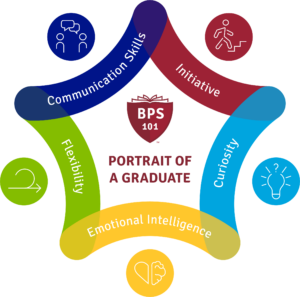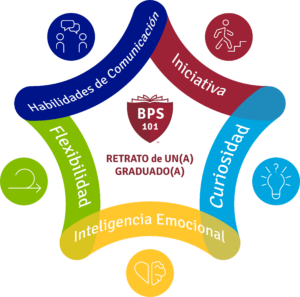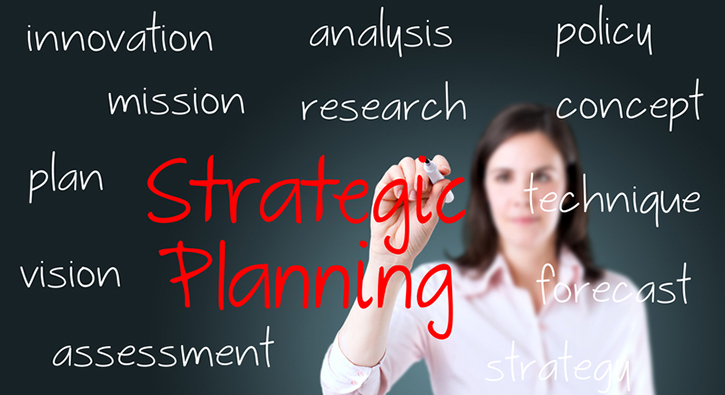BPS101 Strategic Plan (DRAFT)
as of April 26, 2024
Please review the contents of this page, then complete our survey (Linked at the bottom of this page). The Survey Closes on May 8, 2024.
Mission
Batavia Public Schools will be a district recognized for excellence in our commitment to students through a collaborative culture and continuous improvement.
Vision
Empowering every student to achieve their unique potential through an equitable and personalized experience where post K-12 pathways are supported.
Commitments
We commit to students and their learning.
We commit to providing a safe and inclusive learning environment for all students.
We commit to collaboration.
We commit to continuous improvement.
Strategic Goals and Strategies
Strategic Goal One: Teaching and Learning
Ensure maximum development, growth, and achievement for all students.
Measurement Goals
- SEL Surveys
- Achievement Tests
- Academic Growth Metrics
- Achievement Gap Metrics
- Freshmen on Track
- Course & Program Enrollment
- Post-Secondary Experiences
Strategies
- Focus improvement efforts for curriculum, instruction, and assessment on literacy
- Utilize a foundation of resources that prioritizes deep learning and makes strong connections to modern life, learning, and careers
- Adapt to students’ personal learning styles and individual needs
- Improve collaboration and innovation among adults through strong team models and decision-making structures
- Apply continuous improvement to communication efforts within a Professional Learning Community (PLC) framework
- Provide professional development that is collaboratively created in the areas of curriculum, equity, inclusion, cultural awareness
Strategic Goal Two: Inclusion and Belonging
Provide a productive, safe, and supportive learning environment.
Measurement Goals
- SEL Surveys
- Safety Perception Surveys
- Attendance
- Safety & Bullying Incidents
- Extra-curricular involvement
- Communication Access
- Health Office Visits
Strategies
- Incorporate student voice and input as a driver for improvement
- Ensure students experience an equitable and inclusive environment in our schools
- Build community, positive relationships, social and emotional strength & mental health
- Engage families and the community as vital partners in the education process
- Incorporate strategies to recruit a wide range of employees from various backgrounds
Strategic Goal Three: Physical Learning Environment-
Demonstrate effective and efficient business operations and ensure excellent stewardship of public resources and our physical learning environments.
Measurement Goals
- Space Utilization
- System Performance
- Online System Access and Engagement
Strategies
- On schedule with maintenance cycles
- Meet needs for curricular programs
- Meet needs for extracurricular activities
- Safety training and security
- Technology training


Portrait of a Graduate
Overview of the Project
Portrait of a Graduate involves framing a vision of hopes, aspirations, and dreams that our community has for our young people. Our shared vision allows all students to have an educational experience that prepares them to become lifelong learners and contributors. This shared agreement is a unique community-owned picture of what graduates need for success.
Representation on Our Portrait Team
Building a dynamic team that is highly diverse and effectively represents all aspects of our community will contribute to the success of the ultimate outcome. It also sets the stage for a strong base of support in the broader community. Through this inclusive process, the Portrait of a Graduate becomes the community’s collective vision for its students.
The 5 Attributes
Curiosity: Ability to ask questions and seek answers; to synthesize knowledge and connect ideas in new ways and bring unique perspectives; to think critically about complex problems; open to new ideas
Flexibility: Ability to demonstrate perseverance in tasks and thinking, to show resilience and adaptability to overcome challenges and situations; to adapt in the face of challenges in thinking and action (learn, unlearn, re-learn)
Emotional Intelligence: Composed of self-awareness/regulation (self) and social awareness (others), empathy, motivation, and social skills, emotional intelligence allows us to work collaboratively in interconnected environments. (Goleman, 1995) Ability to perspective take; to sense the motives of others and respond with care and concern; to connect deeply and relationally; to express this to others verbally and non-verbally; Ability to earn the trust of others and motivate others to action; the vision for the desired outcome that is communally shared and fostered by the leader; a servant of others; coach others in both actions and in mindset
Communication Skills: Ability to transfer information from one place, person or group to another; to collaborate with others to learn and accomplish tasks; listen actively with an ear to understand others’ views, paraphrase and ask follow-up questions
Initiative: Ability to commit to action; to consider multiple perspectives in order to take action; to navigate both people and knowledge to pursue goals; to take risks; have the skills to learn how to learn; set goals; to avoid blame or victimhood; not a passive observer; finds their voice




